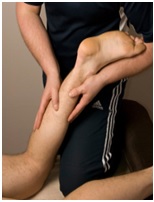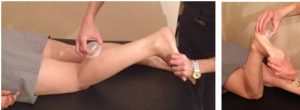A 2018 clinical review based on 6 RCTs concludes that there is evidence to support the use of soft tissue mobilizations but little evidence to support the use of joint mobilization techniques for treating plantar heel pain (PHP).1

One study showed that self-stretching in combination with deep tissue massage applied primarily to the medial head of the gastrocnemius muscle was beneficial for PHP.2
I personally prefer Tissue Distraction Release (TDR)/Cupping instead of any manual massage. Not only do I find it more effective, it is also much easier on the hands and thumbs.

Deciding to cup or not is very simple. On your next patient with plantar heel pain simply palpate the medial gastrocs belly and look for asymmetrical tenderness between the symptomatic and asymptomatic side. If the medial gastroc muscle belly is exquisitely tender, then seriously consider TDR as it can often instantly relieve PHP symptoms in just one session. …sorry I have no published papers specifically on TDR and PHP.
You may simultaneously use the medium sized cup on the calf and the small cup on the plantar aspect of the foot which actually tickles a bit.
Just a bit of warning, TDR on the gastrocs and the soleus is EXTREMELY painful but the pain fully resolves once treatment is stopped. Ensure that you warn the patient and that you receive informed consent three times before performing the TDR. The TDR procedure lasts 2-3 minutes or as tolerated by the pain.
Since you are already an APTEI Report subscriber, you may simply view the short TDR instructional videos in the “Video Library” at www.aptei.ca
- Pollack Y et al Manual therapy for plantar heel pain. Foot (Edinb). 2018 Mar;34:11-16.
- Renan-Ordine R et al Effectiveness of myofascial trigger point manual therapy combined with a self-stretching protocol for the management of plantar heel pain: a randomized controlled trial. J Orthop Sports Phys Ther. 2011 Feb;41(2):43-50.

